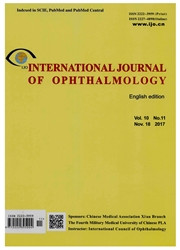

 中文摘要:
中文摘要:
AIM: To characterize the disease-causing mutations in a Chinese family with ectopia lentis syndrome(ELS).·METHODS: Patients and their family members were given complete physical, ophthalmic, and cardiovascular examinations. Genomic DNA samples were extracted from the peripheral blood of the pedigree members and100 healthy controls. Mutation screening was performed in the fibrillin-1(FBN1) gene by bi-directional sequencing of the amplified products. The mutation was analyzed using two bioinformatics methods.·RESULTS: A novel heterozygous c.305G>A mutation in exon 3 of FBN1 was detected. As a result of this change,a highly conserved cysteine residue was replaced by a tyrosine residue(p.C102Y). Another mutation was found in the same exon(c.303T>C), which did not change the amino acid sequence. Both mutations were discovered in each affected individual, but not in the unaffected family members, or in 100 ethnically matched controls. A bioinformatics analysis predicted that mutation p.C102 Y would affect protein function.·CONCLUSION: In the first epidermal growth factor-like module, we identified a novel FBN1 mutation(p.C102Y),which caused ELS in the family. Our study presented a unique phenotype, including some distinct ophthalmic findings, such as hypoplasia of the iris and anisometropia. Our results expanded the mutation spectrum of FBN1 and enriched the overall knowledge of genotype-phenotype correlations due to FBN1 mutations.
 英文摘要:
英文摘要:
AIM: To characterize the disease-causing mutations in a Chinese family with ectopia lentis syndrome (ELS). METHODS: Patients and their family members were given complete physical, ophthalmic, and cardiovascular examinations. Genomic DNA samples were extracted from the peripheral blood of the pedigree members and 100 healthy controls. Mutation screening was performed in the fibrillin -1 (FBN1) gene by bi -directional sequencing of the amplified products. The mutation was analyzed using two bioinformatics methods. RESULTS: A novel heterozygous c.305G>A mutation in exon 3 of FBN1 was detected. As a result of this change, a highly conserved cysteine residue was replaced by a tyrosine residue (p.C102Y). Another mutation was found in the same exon (c.303T>C), which did not change the amino acid sequence. Both mutations were discovered in each affected individual, but not in the unaffected family members, or in 100 ethnically matched controls. A bioinformatics analysis predicted that mutation p.C102Y would affect protein function. CONCLUSION: In the first epidermal growth factor-like module, we identified a novel FBN1 mutation (p.C102Y), which caused ELS in the family. Our study presented a unique phenotype, including some distinct ophthalmic findings, such as hypoplasia of the iris and anisometropia. Our results expanded the mutation spectrum of FBN1 and enriched the overall knowledge of genotype-phenotype correlations due to FBN1 mutations.
 同期刊论文项目
同期刊论文项目
 同项目期刊论文
同项目期刊论文
 期刊信息
期刊信息
